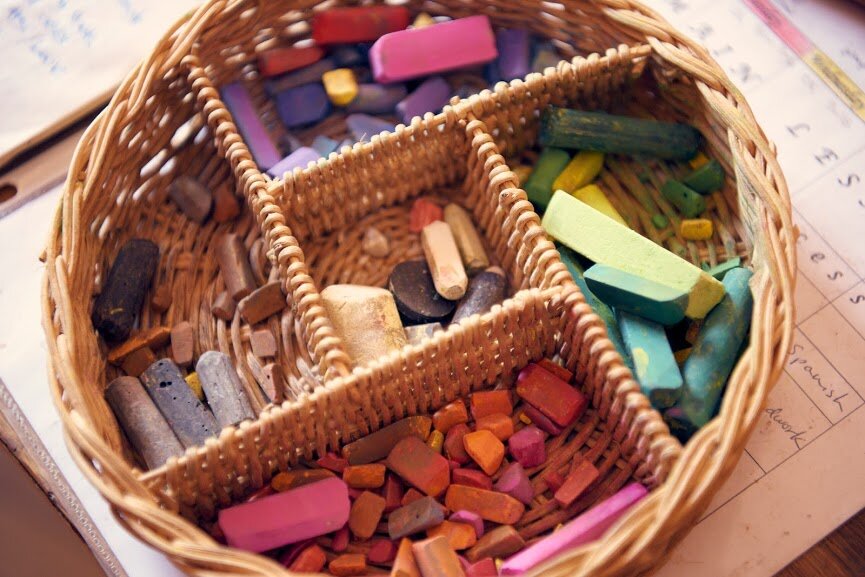Heart=Art: How to set up an art nook for your child
By Lynne Czysz, WSL Early Childhood Teacher
Do you have an art nook set up for your child? If so, I hope you find the following ideas helpful. If not, perhaps this article will inspire you to create one! Having a small corner of the house all to ourselves can feel like a great luxury. This privacy, this space that is designed especially for us, where creativity can spring forth with ease and freedom, can provide a sense of calm.
In our modern day society, there are a multitude of ideas and activities at our fingertips to enjoy with our children. But, what about the space in which a child can quietly construct their own creations, and choose from supplies that have been thoughtfully placed there, just for them?
Designating the space to create privacy does not always mean being alone. Young children like to be close to where we are. The space where we locate our child’s art nook will be one where they can be productive and comfortable. To encourage and foster creativity in our children, we want to show them that we value their work and their time. Turning over a corner of the kitchen, dining room or family room might have the best outcome. While these areas are “prime real estate “ within our homes, there is a reason for this; they are where the family wants to be. Where is the heart of your home? That’s where the art will flourish.
What does a welcoming creative space look like? It could feature:
A throw rug to both mark the area and keep the floor space clean. A child-sized chair should be able to move about easily on, or close to, this rug.
A child-sized table or desk covered with a vinyl tablecloth clamped on with picnic clips or well hidden heavy-duty tape. Adding an unbreakable vase in which the child can place cut flowers or budding twigs is a lovely way to encourage reverence and respect for this special area.
Shelves either pre-assembled or made with items in the home. Working with your child to sand and polish a few old boards from the shed, and stack them on clean bricks, could be a fun and instructive project you can do together.
A side table or shelf for a healthy potted plant brings life and nourishment for the senses.
Twine or any kind of string that can be hung along the wall to define the area and display artwork. Paintings and drawings can be clipped onto the twine with wooden clothespins. Change up the “gallery showing” often. The artwork, once taken down, can be made into a book by using a three-hole paper punch and string as binding.
A cork or chalkboard on the wall to designate space and provide another medium for creativity.
A recycling bin or garbage container placed on the floor. This is not only useful but helps to designate the space. Those tiny scraps of paper will find their way in there when it is close at hand!
Items to stock in the art nook
Coloring mats can be very useful. Not only do they help to protect the surface, but they bring a soft glow to crayon drawings. The coloring mat encourages a sense of purpose and meaningful activity for the child. These can be made by covering a few sheets of newspaper (folded in half) with paper bags (inside out, so the print is not visible) and thick wide tape around the edges. Over time and use, they develop a beautiful patina all of their own.
Rounding the sharp corners of coloring paper creates a softer, more welcoming shape for the young child. Just this small extra preparation can enhance the child’s appreciation of paper as a precious resource, encouraging the use of both sides.
Small baskets and mason jars are useful for child-sized scissors, beeswax crayons, colored pencils, and glue sticks. Wax paper bags can be helpful for scraps of colored papers, special ribbons, and lengths of yarn for finger knitting.
Glitter, paint, sewing baskets and beads might be kept up on a higher shelf, depending on the child’s age and abilities. This helps to mark certain items for a particular time in the week, creating a weekly rhythm in our lives. For example, “we’ll paint on Monday, sand and hammer on Tuesday, bake on Wednesday….” This kind of structure fosters a mood of reverence and a feeling of security within ourselves and our children.
A child-sized apron can be fun to make for or with the child. Above, you will find an idea from the book “Earthways” by Carol Petrash and (below) a photo of an apron that I made many years ago for Nursery students. Kindergarten children may want to finger knit the apron string out of a soft yarn.




